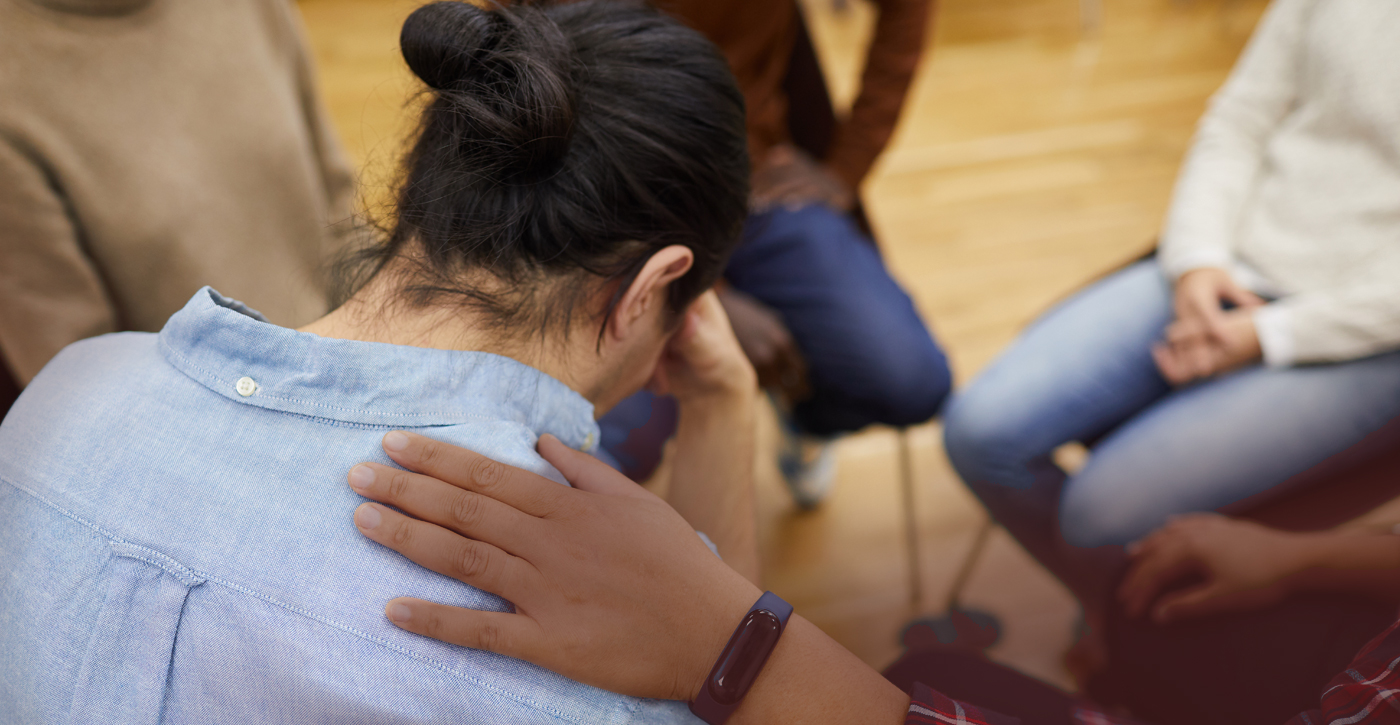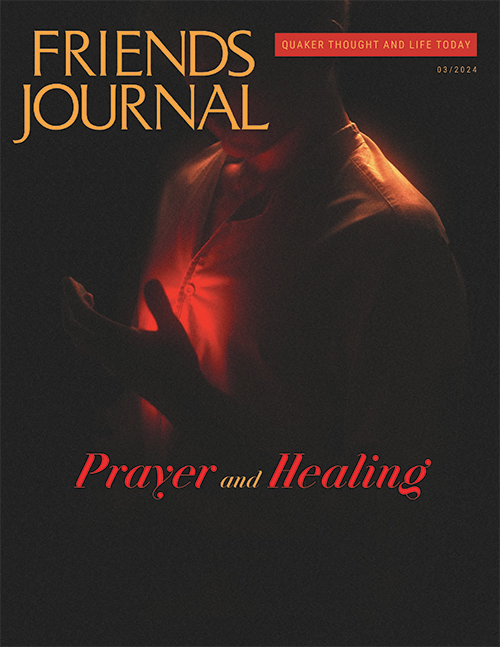I recently had major surgery and spent two weeks in a hospital. Some colleagues and staff from the office told me that they were praying for me; many Friends from my Friends meeting were holding me in the Light. There is a period at the end of our worship at Baltimore’s Homewood Meeting when someone from the Ministry and Counsel Committee announces a time for holding persons in the Light or praying for them, so I was held corporately in the Light for several weeks. These events prompted the current reflection on holding in the Light, prayer, and healing.
At the Friends General Conference Gathering one summer in the late 1980s, I took the workshop of the late Richard Lee on meeting for healing (See “Meetings for Healing in the Manner of Friends” (PDF) by Lee and Merry Stanford in the December 1995 issue of Friends Journal and “Meeting for Worship for Healing” by Lee and Sarah M. Lloyd, April 2018). I helped start a healing group at my meeting in the 1990s and facilitated the group for many years; the group continues though it is now hosted by Stony Run Meeting in Baltimore.
We felt bonded in the healing group. We had regular monthly sessions with many of the same Friends attending. We held hands in a circle for a few minutes at the beginning and end of the sessions (this was prior to COVID).
(As an aside, I’ll say that in this society, we do not connect physically with people very much. When I lived for four years in Europe in the early 1980s—one year in France and three in Belgium—Friends and people who knew each other well often embraced both upon meeting and parting, and they often also gave two or three cheek kisses. I had to end this habit quite rapidly upon moving back to the United States.)
I started our meetings for healing by asking those present for the names of people who needed healing, which could include persons present, and made a list. After an initial silence, I read a name followed by two to three minutes of silence before reading the next name. We also put an empty chair in the center of the circle, and if someone present needed healing, she or he could go and sit in the chair. Then during the two to three minutes, other Friends, with this person’s approval, could step forward and place their hands on the shoulder, arm, forehead, knee, etc. of that person to send healing energy to him or her. One participant knew Reiki techniques of energy and would provide that service at that time. Knowing of George Fox’s Book of Miracles also helped ground us by confirming that healing has a long history among Friends.
We felt bonded in the group, particularly by having a regular monthly session with many of the same Friends attending. But as a scientist, I wondered if any studies had been done to document the effects of prayer on healing.
But as a scientist, I wondered if any studies had been done to document the effects of prayer on healing. In medical science, the gold standard is a randomized trial published in a peer-reviewed journal, which minimizes potential biases. I found such a 2006 study by Herbert Benson et al., titled “Study of the therapeutic effects of intercessory prayer (STEP) in cardiac bypass patients: A multicenter randomized trial of uncertainty and certainty in receiving intercessory prayer.” The study considered three groups of patients who had recently had heart surgery; patients were randomized to the three groups. In the first group were those who were prayed for and knew they were being prayed for. In the second group were those who were prayed for but did not know that they were being prayed for. The third group was a control group that was not prayed for. Complications are quite common among these patients, so that was used as the outcome of interest. The hypothesis, of course, is that those who are prayed for will have fewer complications. Surprisingly, the group that knew they were being prayed for had significantly higher complications rates. The authors stated: “Understanding why certainty of receiving intercessory prayer was associated with a higher incidence of complications will require additional study.” One possible explanation is that those who knew they were being prayed for were possibly more stressed, and stress is not good for those recovering from heart surgery.
In the intervening years, more randomized studies have been done of the effects of prayer on health outcomes. A 2009 review of all ten of the high-quality studies (“Intercessory prayer for the alleviation of ill health” by Roberts, Ahmed, and Davison) produced the following result: “Overall, there was no significant difference in recovery from illness or death between those prayed for and those not prayed for.”
Upon closer inspection, I discovered that in all of the studies those doing the praying did not know the person they were praying for! This is totally different from the experience with meeting for healing and holding someone in the Light at the end of Friends worship. The problem from a scientific perspective is that one can never do a randomized study where those praying know the person being prayed for. Specifically, suppose someone named Susan needs healing. One could not randomize the people who know Susan and tell one random half that they cannot pray for Susan while the other random half can.
Many Friends believe that holding in the Light simply recognizes that Light pervades all of life and that individuals can access that Light and hold a given person or persons in that Light. Might it be so!
There are therefore two possibilities. First, there may be a significant effect of praying or holding in the Light when those praying know the person being prayed for. Many of us have stories of someone we know who was very ill and was prayed for or held in the Light and then was miraculously healed, despite a terrible prognosis from physicians and with no explanation from medical science. But documenting this experimentally is virtually impossible. Or second, whether or not praying has an effect, the relationship between the person praying and the person prayed for is strengthened by the act of praying or holding in the Light. As Friends, we can affirm that holding someone in the Light strengthens our bond with that person. Similarly for the group in meeting for healing, it also creates a bond between members of the group. Prayer and holding in the Light helps the Spirit move among us.
In a related matter at our meeting, every week in the announcements period after worship, we read the names of persons murdered in Baltimore in the previous week. We ask that they and all the persons who knew them be held in the Light. In addition, on a long banner in front of the meetinghouse, we write the names of homicide victims during the year. The banner title for 2024 (changed slightly from the wording for 2023 and earlier years) is “We hold in the Light Baltimore homicide victims and those who knew them—2024.” All persons touched by violence in the city and elsewhere need to be held in the Light.
Whether there was a difference between praying and holding in the Light came up in our monthly meeting for business when one Friend said that some of the pedestrians passing by on the sidewalk next to the banner would not understand the phrase “hold in the Light.” But overall, we felt people would understand and translate it, if needed, using their own experience. To go deeper, I must first make an admission: some may consider me a seasoned Friend, but I am very weak in theology. Thankfully this is not really a problem, because Quakerism is an experiential religion. Anyway, in Christianity, Islam, and some other religions, prayers are from a person to a Supreme Being. On the other hand, many Friends believe that holding in the Light simply recognizes that Light pervades all of life and that individuals can access that Light and hold a given person or persons in that Light. Might it be so!




I really appreciate your exploring prayer through your scientific lens. As a former hospital chaplain, I was called upon to minister to strangers in the emergency room all the time. If someone was open to prayer I would pray with them. I would like to address the issue of prayer with people that you do not know, because that is what I was doing when on call in the emergency room all the time. One of the most traumatic cases that I had was dealing with a woman who was raped early in the morning on her way to work . The rapist not only physically abused her, but disfigured her face. When I met her in the emergency room she was in shock. I held her hand and explained that I would be with her throughout her time in the hospital. She stayed in the hospital for several weeks and went through many surgeries to restore her face. I asked her if she would be open to me inviting my colleagues to lay hands on her for healing. She said yes. Before the bandages were to be removed from her face for the first time, I asked the other Protestant chaplains to join me and lay hands on her for healing both physically, spiritually, and emotionally. I knew she would need a tremendous amount of support to get through this. She had not met the other chaplains when they came into the room, but she trusted me. We all laid hands on her in the bed and prayed. After the prayer was over we could see a change in her eyes. We could see that her body had a physical response to the prayer. When she was able to see herself, she was able to accept the changes in her appearance with grace. I think that our prayers helped contribute to that acceptance. I do believe that prayer has an effect on individuals whether we know them or not. I say this from my personal experience of being with others in a hospital setting.